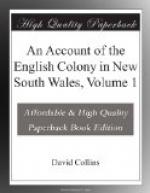[* During the Fancy’s stay in the river Thames, they had many and almost daily proofs of Too-gee’s want of veracity on this head.]
Too-gee described a large fresh-water river on the west side of Ea-hei-no-maue; but he said it was a bar river, and not navigable for larger vessels than the war canoes. The river, and the district around it, is called Cho-ke-han-ga. The chief, whose name is To-ko-ha, lives about half-way up on the north side of the river. The country he stated to be covered with pine-trees of an immense size. Captain King says, that he made Too-gee observe, that Captain Cook did not in his voyage notice any river on the west side, although he coasted along very near the shore. On this Too-gee asked with much earnestness, if Captain Cook had seen an island covered with birds. Gannet Island being pointed out, he immediately fixed on Albatross Point as the situation of the river, which Captain Cook’s account seems to favour, who says, ’On the north side of this point (Albatross) the shore forms a bay, in which there appears to be anchorage and shelter for shipping.’ Governor King on this subject remarks as follows:
The probable situation of this river (if there be one) being thus far ascertained, leads me to suppose, that the district of T’Souduckey extends from Cape Runaway on the east side, to Cape Egmont on the west, and is bounded by Cook’s Strait on the south side, which is nearly one half of the northern island. Of the river Thames I could not obtain any satisfactory account; but I have great reason to suppose, that the river he has marked in the district of Wonga-ro-ah is the Thames. Toogee’s residence appears to be on the north side of the Bay of Islands, in the district called by him Ho-do-do, which he says contains about a thousand fighting men, and is subject to the following chiefs; i.e. Te-wy-te-wye, Wy-to-ah, Moo-de-wye, Wa-way, To-mo-co-mo-co, Pock-a-roo, and Tee-koo-ra, the latter of whom is the principal chief’s son. The subordinate distinctions of persons at New Zealand are as follow: (We are told, that the inferior classes are perfectly subordinate to their superiors; and such I suppose to be the case by the great deference always paid by Too-gee to Hoo-doo.)
Etang-a-teda Eti-ket-ti-ca, a principal chief, or man in very great authority. His superior consequence is signified by a repetition of the word eti-ket-ti-ca. This title appears hereditary.




